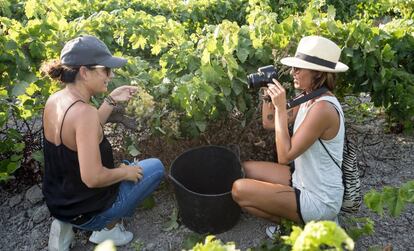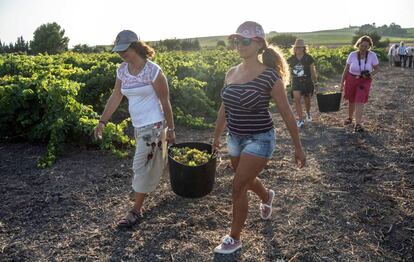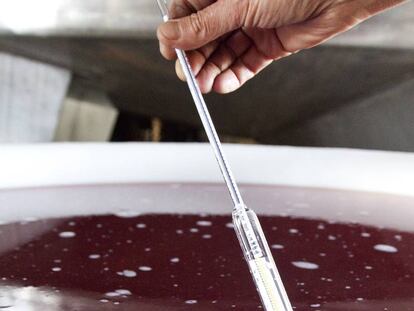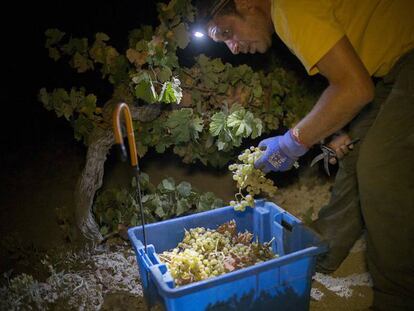The tourists paying €25 to be grape harvesters for a day in Spain
An initiative by a sherry wine maker in Jerez de la Frontera is attracting foreigners and locals alike


The sun has been setting on the Plantalina estate for a while, but even that has failed to bring the temperature down. The thermometer says 38ºC, but the warm easterly wind aggravates the sweltering heat in this vineyard in Jerez de la Frontera. The landscape in this corner of southern Spain, with its miles of vines clinging to the rolling hills, is a beauty to behold. But working with it is another story entirely.
Maritza Vela should know. “I’m all emotional. This is so beautiful,” she says, crouching over the vines. Vela, who comes from Colombia, is not a day laborer. Nor is this vineyard her property. What’s more, she has paid €25 for the chance to harvest the Palomino grapes that she will later crush with her feet to make the sherry wine that this region is famous for the world over.
We get grandfathers who once worked as manual harvesters and who now want to show their family what it used to be like
Cecilia Rodríguez, Spirit Sherry
Vela is one of 270 tourists and locals who have paid between €15 and €30 to take part in an initiative called Vendimia con nosotros (Harvest With Us), organized by the local company Spirit Sherry. This is the sixth year that Cecilia Rodríguez and Eduardo Valderas, two entrepreneurs and wine experts from Jerez, have turned visitors into laborers for a few hours.
Valderas still remembers the local reaction they got in 2013, when they announced it for the first time. “They cut the grapes for you, and they pay you for it too, after all I’ve been through to harvest it?” industry leaders asked. “They couldn’t believe it,” laughs Valderas.
But the activity has taken off since then. “This year our groups have multiplied by four compared with 2017”, says Rodríguez. Spirit Sherry has organized up to nine groups of 30 members each, who have been collecting grapes up until this past weekend, coinciding with the large wineries’ harvest time.

The initiative still raises eyebrows in a sector where grape collection has become mostly a mechanical affair, and where wine tourism largely means visits to wineries and tastings. “Around 70% of the grape gets harvested by machines. We want to illustrate the importance of manual work,” says Rodríguez.
Victoria Miller agrees enthusiastically. “Do you know what it’s like to feel the grapes under your feet?” she asks. Miller is in charge of D’Sherry Explorers, an assorted group of local and foreign sherry wine aficionados who never fail to show up here every year. On a recent August evening, as the sun was setting on the seven-hectare estate, more than 20 members of this association were hard at work picking grapes.
Divided into pairs, the amateur harvesters walk up and down the rows of vines, stopping for selfies along the way. For Vela and her husband, Nelson Espitia, this is their first time inside a vineyard, and they are excited. They snip each bunch with loving care, then deposit it inside a basket. “I’m an engineer at a bottle-stopper company and I wanted to learn the process from the beginning. We had never seen this, it’s beautiful,” says Espitia, who has been living in Cádiz for a year.
Investing in enotourism
The wineries in the Marco de Jerez – also known as the Sherry Triangle – where this fortified white wine is made, have been embracing tourism in recent years. Most of the bigger brands offer guided tours and tastings, and the regional government is channeling EU funds to support original initiatives such as Spirit Sherry’s. Over at Viña La Constancia, tourists are being offered tastings on boats, picnics, off-road trips among the vines and even siestas among the barrels.
Yet the typical client who signs up for the initiative is not a foreigner who is unfamiliar with the world of wine. “We get a lot of local groups. Also fathers and grandfathers who once worked as manual harvesters and who now want to show their family what it used to be like,” explains Rodríguez.
Although Maritza and Nelson may feel like the stars of the 1995 movie A Walk in the Clouds, filmed in Napa Valley, the two-hour effort makes it clear that this is a tough job. Just like the real laborers of old – and some who continue to work by hand – each pair of visitors has brought their fruit-laden basket to the spot where they will crush it. Kicking off their shoes and grabbing each other’s shoulders, the Colombian couple get to work.
“Each basket produces eight to 10 liters of must, and with this we will make the wine that will be ready next year,” explains Valderas.
Just a few steps away from Maritza and Nelson, Lucía Arroyo and Mar Barrios can’t help giggling as they crush the grapes. “Well at least our skin is going to get real nice and soft,” says Arroyo, who is from Valencia. For Barrios, who is from Jaén, this is her first experience with grapes but not with harvesting. “My family owns fields of olive and cherry trees,” she explains. “Just look at me. These pictures are for my dad. Didn’t you want olives Dad? Well here’s some real harvesting for you!”
English version by Susana Urra.
Tu suscripción se está usando en otro dispositivo
¿Quieres añadir otro usuario a tu suscripción?
Si continúas leyendo en este dispositivo, no se podrá leer en el otro.
FlechaTu suscripción se está usando en otro dispositivo y solo puedes acceder a EL PAÍS desde un dispositivo a la vez.
Si quieres compartir tu cuenta, cambia tu suscripción a la modalidad Premium, así podrás añadir otro usuario. Cada uno accederá con su propia cuenta de email, lo que os permitirá personalizar vuestra experiencia en EL PAÍS.
¿Tienes una suscripción de empresa? Accede aquí para contratar más cuentas.
En el caso de no saber quién está usando tu cuenta, te recomendamos cambiar tu contraseña aquí.
Si decides continuar compartiendo tu cuenta, este mensaje se mostrará en tu dispositivo y en el de la otra persona que está usando tu cuenta de forma indefinida, afectando a tu experiencia de lectura. Puedes consultar aquí los términos y condiciones de la suscripción digital.
More information
Archived In
Últimas noticias
Most viewed
- Reinhard Genzel, Nobel laureate in physics: ‘One-minute videos will never give you the truth’
- Oona Chaplin: ‘I told James Cameron that I was living in a treehouse and starting a permaculture project with a friend’
- Pablo Escobar’s hippos: A serious environmental problem, 40 years on
- Chevy Chase, the beloved comedian who was a monster off camera: ‘Not everyone hated him, just the people who’ve worked with him’
- Why we lost the habit of sleeping in two segments and how that changed our sense of time










































